How to Visualize Feedback Scores With NPS Reports
Read More
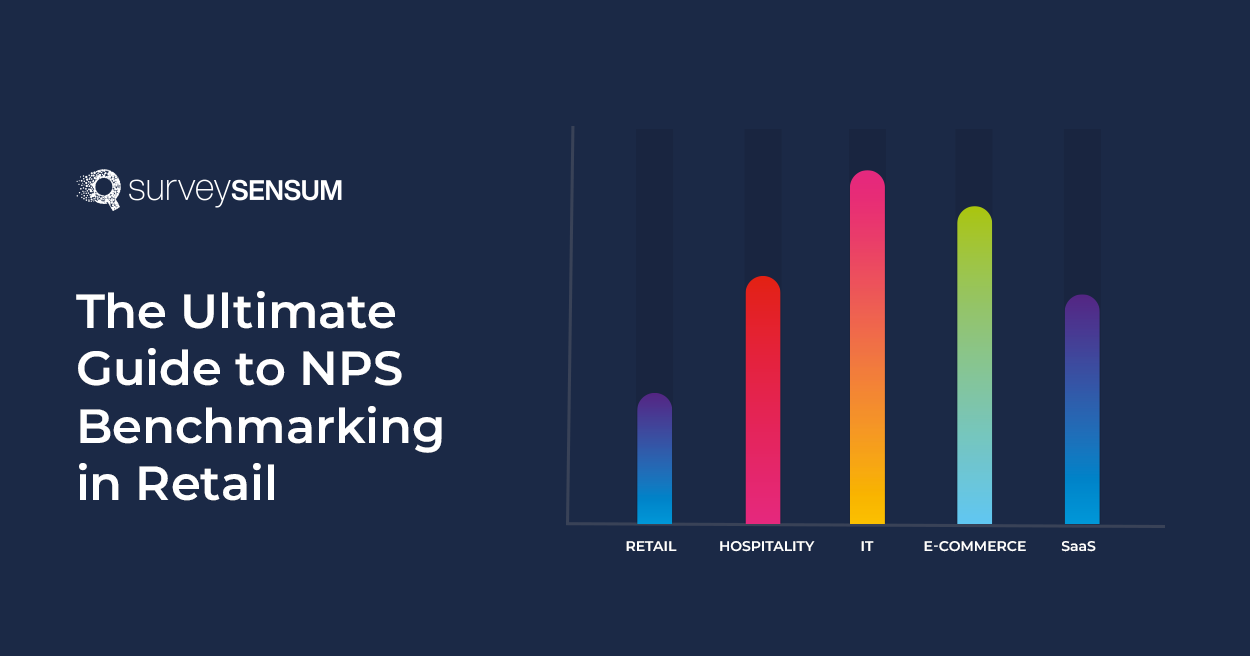
Retail businesses thrive on repeat customers. Therefore understanding these customers isn’t just helpful but essential. And the simple and effective tool to achieve this is the Net Promoter Score (NPS).
The NPS score of your business determines how loyal your customers are and how likely they are to recommend you to others. Higher NPS scores indicate you have more customers to promote your business. But the NPS score isn’t enough.
You need to know where you stand in the market, whether you are underperforming or merely meeting industry standards. And this is where NPS benchmarking in retail comes into play.
Benchmarking the NPS score of your retail business with your competitors can help you understand what they are doing better than you and improve your overall business performance.
In today’s retail landscape, customer loyalty is a currency that’s hard to come by. Therefore NPS Benchmarking is a must-have weapon in your customer experience arsenal.
In this blog, we discuss the importance of NPS benchmarking in retail, the factors affecting it, how to benchmark NPS to enhance retail customer experience, and more.
Let’s start with the basics – NPS score
It is the difference between the percentage of promoters and detractors of your business. It lets you know whether you have more promoters or detractors.
The calculation of NPS in retail is no different from calculating the NPS score in general.
Start by conducting a survey and asking NPS questions like the following –
“On a scale of 0 to 10, how likely are you to recommend our retail business to your friends or family?”
The results could be any number between 0 – 10, and we can classify and segment customers according to their ratings.
So, to calculate the NPS score of your business, start by finding the percentage of promoters and detractors.

For instance, if the percentage of promoters is 25% and detractors is 20%, then the NPS score will be,
NPS score = 25 – 20 = +5
A positive NPS score is generally good, and it means that you have more promoters than detractors.
If your business has a negative NPS score, it would mean that you have more detractors. This is not good, as detractors can bad mouth their experience with your business and damage the brand value.
Any number above 0 is considered to be a good NPS score. If we are talking in general, a score above 30 is very good, and above 60 is excellent.
But this is not the case every time. Certain factors like industry, target audience, and region play a crucial role in determining the goodness of an NPS score. And an NPS score is considered good only if it equals or exceeds the industry average.
So what is the average NPS score in the retail industry?
According to research done by Satmetrix in 2022, the industry average NPS score of online shopping (retail) is 41.
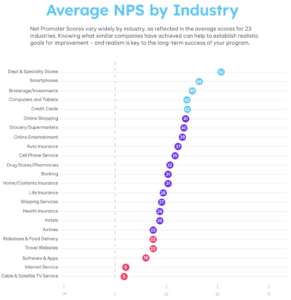
Therefore, if your retail business has an NPS score of 41 or above, you are on the right track. Otherwise, it’s high time to start listening to your customers and improving your business.
Now that we have understood what the NPS score means let’s move on to NPS benchmarking in retail.
NPS benchmarking in retail is the process of comparing your business’s NPS score with the industry average or competitors. This is done to get an overall understanding of how the customers perceive your business when compared to others.
Also, it can be a good indicator to let you know that you are performing better (or worse) than your competitors.
So when considering NPS benchmarking in retail, you will have to find the NPS score of your competitors and the average score in the retail industry.
For example, we know that the industry average for NPS in retail is 41. So, if your business has a score lower than 13 and your competitors have a score equal to or above 41. Then it means there is a lot of room for you to improve customer loyalty and satisfaction.
You can analyze the feedback, especially from detractors, to see what your competitors are doing right and where you are falling short.
There are several reasons that make NPS crucial for retail businesses, following a few of them.
Launch NPS Program with SurveySensum
Now before jumping into how to benchmark, there are certain factors you need to consider.
When done correctly, NPS can yield fruitful results and enhance customer experience. Therefore it is important to consider the following factors before benchmarking your NPS score.
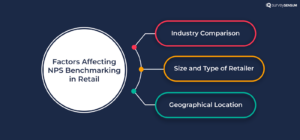
When benchmarking your NPS, it is essential to consider your industry. Each industry has its unique characteristics, customer expectations, and competitive landscape.
Comparing your NPS score with others in your industry will help you get an idea of how well your business is performing compared to your peers. As a result, you understand whether the score meets the industry average or not. And also, you can determine where you stand regarding customer loyalty and satisfaction.
For example, if you are running a fashion retail business, it is ideal to benchmark your NPS against other fashion retailers. This will help you understand if your customer experience efforts are on par or lagging with the industry standard.
Additionally, you can identify areas that need improvement and implement proper strategies to improve them.
The size and type of retail business can also impact your NPS benchmarking analysis. In addition, other factors that need to be considered are location, target audience, and product/services. Therefore it is crucial to consider businesses that are comparable with respect to yours.
For example, it’s not ideal to benchmark the NPS of a small boutique retail store to a large chain boutique with nationwide coverage. Instead, focus on benchmarking against retailers of similar size and operations scope. This ensures that relevancy while comparing and provides actionable insights you can use to improve customer loyalty.
The geographical location is another factor that can influence NPS benchmarking. Customer preferences, cultural nuances, and market dynamics vary with country or region. So it is essential to consider benchmarking within your specific location.
For example, consider the retailer Amazon. They have retail operations across multiple countries across the world. The customer preferences and needs in the USA would be different from those in India. Thus Amazon must benchmark its NPS score in the US with other retailers in the US and similarly for India.
Doing so allows Amazon to tailor the shopping experience to meet the needs and requirements of customers in each location.
By considering the above-mentioned factors, you can make the most out of your NPS benchmarking in retail. Now that we have understood the factors to consider let’s find out how you can benchmark your NPS surveys.
Following 8 simple steps to help you effectively do NPS benchmarking in retail.
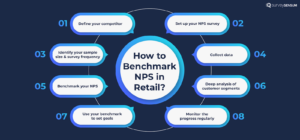
The first and foremost step to do is to research and define your competitors. There is no point in benchmarking against someone who doesn’t provide the same service/product as you are.
Conduct proper research and identify the region, the target audience, the type of product, etc., to determine your competitors.
By understanding the competitive landscape, you can interpret the NPS in context and plan more effectively.
Choose the proper channels, like email, WhatsApp, in-app, etc., to launch the NPS survey. You have to reach out to where your customers are. This is one way to ensure survey engagement.
Once you have set the channel/s, add necessary NPS questions, including follow-up questions. This will help you gain further insights and let you understand the reason behind their NPS score.
Finally, ensure the survey is clear, concise, and easy to respond to.
Determine the frequency of the survey and the proportion of your customer base.
It’s important to strike a balance when sending out surveys. If you survey too often, you risk survey fatigue among your customers, leading low response rate. At the same time, if you survey too infrequently, you miss out on valuable insights. Depending on the type of retail business, this frequency can vary.
Now when it comes to sample size, if you have a large customer base, it’s best to select a representative sample for the survey. This sample should be large enough to provide reliable data and small enough to manage. And if you have a smaller customer base, you can survey all your customers.
Once survey responses start coming, calculate the NPS of your business. You can organize the respondents into promoters, passives, and detractors. Find the difference between the percentage of promoters and detractors to find your NPS score.
The score you get can be anything from -100 to +100. A negative score would indicate you have more detractors, and a positive would indicate you have more promoters. See if your NPS score is good or not.
But finding your NPS score isn’t enough. You need to find the industry average as well as your competitors. You refer to public records and data, research papers, etc., to find the necessary information. Also, connecting with reputable market research firms will be another way to acquire this data.
Now that you have the NPS scores, you need to understand what it means, and that’s where benchmarking comes in. You should benchmark your NPS in three ways –
Once you have completed the benchmarking, it is always a good idea to do a deep analysis of different customer segments. This could include segments based on demographics, purchase frequency, or other related characteristics.
By sending surveys targeted to these segments, gather feedback and calculate the NPS for each. Analyze the feedback and jot down the significant difference in the NPS score between segments.
For instance, you might see higher NPS among repeat customers than first-time buyers. In this case, you can focus more on implementing customer retention strategies.
You can set realistic goals for improvement based on your NPS benchmarking. This is essential, especially when your NPS score is lower than your competitors or industry average. Set a clear target for improvement, like increasing the NPS by 15% over the next quarter.
Once you have set the goal, research and identify strategies to help you meet that goal. We will discuss this further and in detail in the next section.
Now, NPS is not a one-time process. Therefore, it is essential to continuously track it and adjust your strategies as necessary. It also lets you keep a tab on the pulse of your customer’s satisfaction and loyalty level.
And also ensure that your efforts are leading to improvement and business growth.
Some strategies to improve your NPS scores are as follows –

The best way to improve your NPS is to listen to your customers and act on their feedback. Though both positive and negative feedback should be addressed, the primary importance should be on the negative ones. They are basically detractors who can damage your brand reputation.
Promptly respond to their feedback, understand where you have gone wrong, resolve it, and let them know of the changes you made. By closing the feedback loop, you address the issues effectively and even convert detractors into promoters.
One of the demerits of online shopping is the unpredictability of product quality and availability. Sometimes products could have been damaged while shipping. Or even worse, sellers online might be selling second products as brand new. So, being an online platform that assures top-quality products would be a start.
And if a customer’s favorite item is frequently out of stock, they are bound to churn and might even become detractors. You could improve the supply chain management or use software to better predict sales.
It is hard for any business to avoid problems or issues. It’s inevitable. Therefore, it is important to have great customer support by your side.
Ensure that your customer support team is well-trained and knowledgeable about the products. For example, they should know the product’s availability, the potential sellers in an area, the average delivery time, and more.
Also, let them know the importance of customer experience and the pivotal role they play in improving it. This way, you can ensure an informed-friendly support team for your customers.
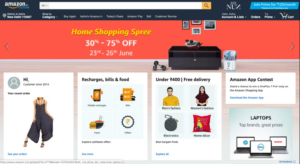
Tailoring the shopping experience to individual customers can increase satisfaction. This could be anything from greeting customers by name to personalized product recommendations. Retailers like Flipkart and Amazon offer such targeted suggestions based on customer purchases and browsing history.
In the highly competitive retail industry, offering a hassle-free return or exchange policy can be a significant differentiating factor. Moreover, this can alleviate customers’ concerns and ease their purchase decisions.
It is crucial to offer a straightforward process to resolve any issues customers have with the product. A seamless return/exchange policy ensures that customers have a smooth experience here. By inducing a positive experience, you can enhance the customers’ perception of your brand.
Furthermore, it builds confidence in customers, and they are likely to trust your business for future purchases.
An example of how having a great return/exchange policy helps your NPS, take a look at Nordstrom’s return policy.
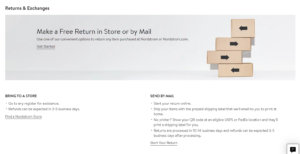
Rewarding your customers with a loyalty program is another effective way to improve the NPS score. A well-structured loyalty program will reward your customers and encourage them to continue engaging with your business.
Examples of loyalty programs will be offering discounts and free giveaways.
However, while creating the program, you should keep your customer base in mind and their preferences. What worked for one business doesn’t need to work for yours.
Now what you need to keep in mind is that improving the NPS score in retail is an ongoing process. It requires regular monitoring and adjustments based on customer feedback.
Following are some types of loyalty programs you can use for your retail business.
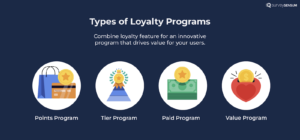
As you may have understood by now, NPS benchmarking in retail is a key success factor. It helps businesses with insights into customer loyalty and reveals opportunities for improvement and growth.
The trail landscape is dynamic and is bound to evolve over the years. Therefore it is crucial to regularly benchmark and improve your business. In a way, retailers can leverage NPS benchmarking to understand their customers’ pulse and stay up to date with their needs.
While NPS benchmarking in retail business helps increase the NPS score, it shouldn’t be the focus. Rather, you should understand your customers and deliver an exceptional retail experience. Your effort towards this goal will pave the way to increased loyalty, better performance, and a thriving retail business.
Choose an effective retail customer feedback platform like SurveySensum to share your NPS survey. You can try out the software for free with unlimited surveys, questions, and users.
